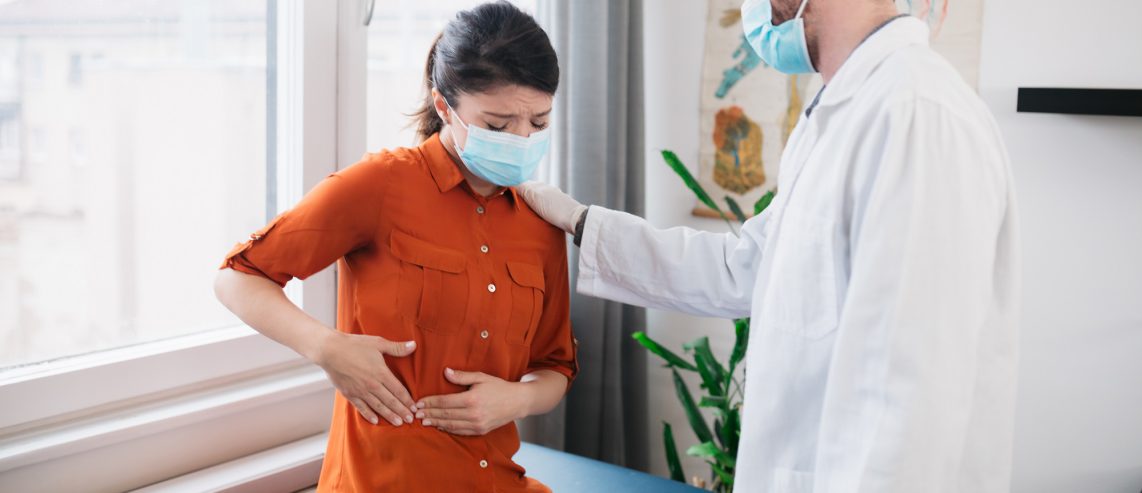You may not think too often about your gallbladder. It’s a small pear-shaped organ near the liver that stores and releases digestive juice, called bile.
But if you experience a gallbladder attack, you will become well acquainted with this small organ. The pain can be so intense, people having a gallbladder attack often can’t think about anything else.
Gallbladder attacks happen when hard deposits — called gallstones — get lodged in a narrow opening and block bile from moving.
If you think you might be having a gallbladder attack, seek treatment promptly. Swollen gallbladders can cause infection and other serious health problems.
What Causes a Gallbladder Attack?
A gallbladder attack happens when a gallstone gets stuck in the tube that connects the gallbladder to the liver and small intestine. This causes bile to build up in the gallbladder, leading to pain and swelling.
Gallstones are usually made up of cholesterol. Cholesterol is naturally present in bile, but if bile has too much of this, it can crystallize and form stones.
Most gallstones don’t cause gallbladder attacks. For this reason, doctors don’t treat gallstones if they’re not causing symptoms. (Many people find out they have a gallstone when they get an imaging test for another problem.)
Although it’s rare, issues other than gallstones can gallbladder attacks. These include a tumor or scar tissue in the bile duct.
Never Miss a Beat!
Subscribe to Our HealthBeat Newsletter!
Thank you for subscribing!
You can now select the specific newsletters you'd like to receive.
You are already subscribed.
Subscribe to more newsletters in our email preference center.
Sorry, an error occurred. Please try again later.
Get Healthy Tips Sent to Your Phone!
What Does a Gallbladder Attack Feel Like?
A gallbladder attack feels like sharp pain in the upper right side or center of the abdomen. This pain can spread to the right shoulder, chest, and mid-back.
Many people experience pain for several hours, and it is often very intense. The discomfort can worsen when you breathe deeply.
Gallbladder attacks often happen within a few hours of a heavy meal. That’s why they often occur in the evening or night.
Gallbladder attack symptoms
In addition to pain, gallbladder attack symptoms can include:
- Nausea or vomiting.
- Sweating.
- Fever, which may involve chills.
- Pale-colored stools.
- Yellowing of the skin or whites of the eyes. (This is sometimes called jaundice.)
When to Go to the Hospital for a Gallbladder Attack
If not treated, gallbladder attacks can get worse. A blocked gallbladder can become infected, and that infection can spread to nearby organs and possibly lead to sepsis. A blocked gallbladder can also burst, which can be life threatening.
You should to the hospital if you have pain, like that described above, that lasts beyond an hour or two. But seek treatment right away if you have a fever on top of sharp pain in the upper right or center of your abdomen. This combination means it’s even more likely you’re having a gallbladder attack.
Your doctor will order an ultrasound if they suspect a gallbladder attack. If it is your gallbladder, the ultrasound will typically show one or more stones caught in the bile duct. Your gallbladder may also look larger than normal.
In some cases, doctors might need to order other imaging tests. For instance, your doctor may suggest a hepatobiliary iminodiacetic acid (HIDA) scan.
For this scan, a nurse or technician injects a radioactive tracer in a vein, that travels through the blood. It’s processed by the liver and is then secreted into the bile.
You then lie on a scanning bed, and a special scanner measures the energy released by the tracer. A computer turns these measurements into images, which show how the bile moves through the body.
If your doctor doesn’t see sure signs of a gallbladder attack, they will look for other signs that might explain cause severe pain. These include an infected appendix, sores in the digestive lining, or a problem with the pancreas, among other causes.
How Do Doctors Treat a Gallbladder Attack?
Doctors treat gallbladder attacks first with pain medication. They also prescribe antibiotics to reduce the risk of an infection arising from the blockage. While gallbladder attacks can resolve after a few days, people remain at a high risk of repeated attacks.
As a result, in most cases, doctors will recommend surgery to remove the gallbladder. Surgeons can usually perform the surgery laparoscopically (with small incisions). In many cases, people can go home within a day or two of surgery.
Living without a gallbladder
Without a gallbladder, the liver releases bile directly into the intestines. That means people without a gallbladder can still digest food normally.
But they may have to make dietary changes. They may not be able to eat large amounts of food or fatty food without feeling gassy or getting diarrhea.
Alternatives to surgery
For those who have health conditions that could make gallbladder surgery risky, doctors recommend other treatments.
For example, doctors can send a scope down the throat and use real-time X-ray imaging and tools to remove or break up gallstones.
Some medications can also help dissolve gallstones. But in the long run, these options aren’t as effective as surgery.
Another option is percutaneous cholecystostomy. Through a small needle, the doctor inserts a tiny drainage tube into the gallbladder. The bile can then drain into a bag outside the body.
This greatly reduces the immediate risk of gallbladder rupture and gives time for the gallstone to become dislodged on its own. After several weeks, the doctor orders a scan to ensure the gallstone is no longer blocking the opening. Then, they can remove the drainage tube.
Still, the risk of repeated gallbladder attacks remains high. Doctors typically reserve this procedure for patients who are too sick to undergo major surgery.
Who Is Most Likely to Get a Gallbladder Attack?
The following risk factors increase the likelihood of a gallbladder attack:
- Being overweight or obese.
- Eating a diet high in saturated fats.
- High levels of cholesterol in the blood.
- Pregnancy.
- Medications that contain estrogen (such as oral contraceptives or hormone replacement therapy), which can increase cholesterol in the gallbladder.
- Diets that include long or frequent fasting periods, as this can lead to more concentrated bile.
- Rapid weight loss (when the body breaks down fat, this process can increase cholesterol in the gallbladder).
- Older age.
More rarely, gallstones form not from cholesterol, but bilirubin. This is a chemical released when the body breaks down red blood cells.
Some health problems can up the risk of gallbladder attacks from bilirubin stones, like sickle cell anemia, cystic fibrosis, and liver disease.
How Can I Prevent a Gallbladder Attack?
Fat in the diet triggers the gallbladder to contract and release bile to help digest the fat. Harder-to-digest saturated fat can cause rapid bile release, which can increase the chances of a gallbladder attack.
That’s why diets low in saturated fats can help prevent gallbladder attacks. That means reducing the amount of fried foods, dairy products, and meat in the diet.
Instead, experts suggest eating plenty of fruits, vegetables, and whole grains. Foods with unsaturated fats, like nuts and olive oil, can also help you avoid gallstones by promoting healthy bile movement.
Given that being overweight or obese increases the risk of gallstones, losing weight can help prevent gallstones. But rapid weight loss can increase the risk of gallstones, so slow and steady weight loss is best.
Sources
American College of Gastroenterology. Gallstones in women. Link
American College of Gastroenterology. Biliary Tract Disorders, Gallbladder Disorders, and Gallstone Pancreatitis. Link
Dr. Christina Lindenmeyer. Cholelithiasis. Merck Manuals. Link
National Institute of Diabetes and Digestive and Kidney Disease. Gallstones. Link
MedlinePlus. Laparoscopic gallbladder removal. Link
Dr. Jasmin Tanaja. Cholelithiasis. StatPearls. Link
Dr Salam Zacko. Overview of nonsurgical management of gallbladder stones. UpToDate. Link
About Primary Care
The relationship with a patient and their primary care doctor can be extremely valuable, and that’s what you get with UPMC Primary Care. When you work with a primary care physician (PCP), you develop a lasting relationship. Your doctor will get to know you and your history and can plan your treatments accordingly. Our PCPs offer a variety of services, including preventive care and treatment for both urgent and chronic conditions. With dozens of UPMC Primary Care locations across our network of care, you can find a PCP close to you. Schedule an appointment today.

